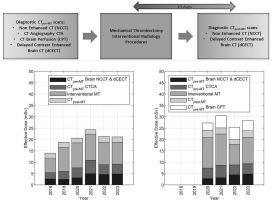急性缺血性脑卒中住院期间患者辐射剂量:某三级转诊医院5年经验
IF 2.7
3区 医学
Q1 RADIOLOGY, NUCLEAR MEDICINE & MEDICAL IMAGING
Physica Medica-European Journal of Medical Physics
Pub Date : 2025-06-05
DOI:10.1016/j.ejmp.2025.105016
引用次数: 0
摘要
目的评估急性缺血性脑卒中(AIS)住院期间局部辐射剂量水平,并量化个别x线检查对累积有效剂量的贡献。方法对行透视引导下机械取栓术(MT)的AIS患者进行剂量学调查。使用商用辐射剂量监测系统(RDMS)收集辐射剂量数据,从医院信息系统(HIS)提取临床数据,并与剂量记录合并进行综合分析。确定所有x线检查的局部剂量水平,包括入院诊断CT扫描、MT和出院前随访CT。结果共分析了670例MT手术。中位Kerma面积积(KAP)为115 Gy·cm2 (IQR: 69-189)。CT扫描的中位剂量长度积(DLP)值为:入院时颅脑CT, 1091 mGy·cm (IQR: 782-1171);CT血管造影:1077 mGy·cm (IQR: 773-1187);CT灌注2529 mGy·cm (IQR: 2055-2961);放电时脑CT值为844 mGy·cm (IQR: 689-946)。整个工作流程的累积有效剂量估计为22.4毫西弗(IQR: 17.1-29.7),介入治疗约占50%。CT灌注占额外的5 mSv。结论:本研究量化了在大容量介入放射室治疗的AIS患者的MT和相关CT成像的局部辐射剂量水平。22毫西弗的累积有效剂量与整个患者工作流程有关,其中MT程序约占50%。需要进一步的研究来评估复杂护理途径中的器官剂量,以估计患者特异性辐射风险。本文章由计算机程序翻译,如有差异,请以英文原文为准。

Patient radiation dose during hospitalization for acute ischemic Stroke: Five years of experience of a single tertiary referral hospital
Purpose
To assess local radiation dose levels and quantify the contribution of individual X-ray procedures to the cumulative effective dose during hospitalization for acute ischemic stroke (AIS).
Methods
A dosimetric survey was conducted in AIS patients undergoing fluoroscopically guided mechanical thrombectomy (MT). Radiation dose data were collected using a commercial Radiation Dose Monitoring System (RDMS) while clinical data were extracted from the Hospital Information System (HIS) and merged with dose records for comprehensive analysis. Local dose levels were determined for all X-ray procedures, including admission diagnostic CT scans, MT, and follow-up CT before discharge.
Results
A total of 670 MT procedures were analyzed. The median Kerma Area Product (KAP) was 115 Gy·cm2 (IQR: 69–189). Median dose-length product (DLP) values for CT scans were: Brain CT at admission, 1091 mGy·cm (IQR: 782–1171); CT angiography, 1077 mGy·cm (IQR: 773–1187); CT perfusion, 2529 mGy·cm (IQR: 2055–2961); and Brain CT at discharge, 844 mGy·cm (IQR: 689–946). The estimated cumulative effective dose for the complete workflow was 22.4 mSv (IQR: 17.1–29.7), with interventional procedures contributing approximately 50 %. CT perfusion accounted for an additional 5 mSv.
Conclusions
This study quantified local radiation dose levels for MT and associated CT imaging in AIS patients treated in a high-volume interventional radiology suite. A cumulative effective dose of 22 mSv is associated with the entire patient workflow, with MT procedures accounting for approximately 50 %. Further research is needed to assess organ dose in complex care pathways, as an estimate of patient-specific radiation risk.
求助全文
通过发布文献求助,成功后即可免费获取论文全文。
去求助
来源期刊
CiteScore
6.80
自引率
14.70%
发文量
493
审稿时长
78 days
期刊介绍:
Physica Medica, European Journal of Medical Physics, publishing with Elsevier from 2007, provides an international forum for research and reviews on the following main topics:
Medical Imaging
Radiation Therapy
Radiation Protection
Measuring Systems and Signal Processing
Education and training in Medical Physics
Professional issues in Medical Physics.

 求助内容:
求助内容: 应助结果提醒方式:
应助结果提醒方式:


